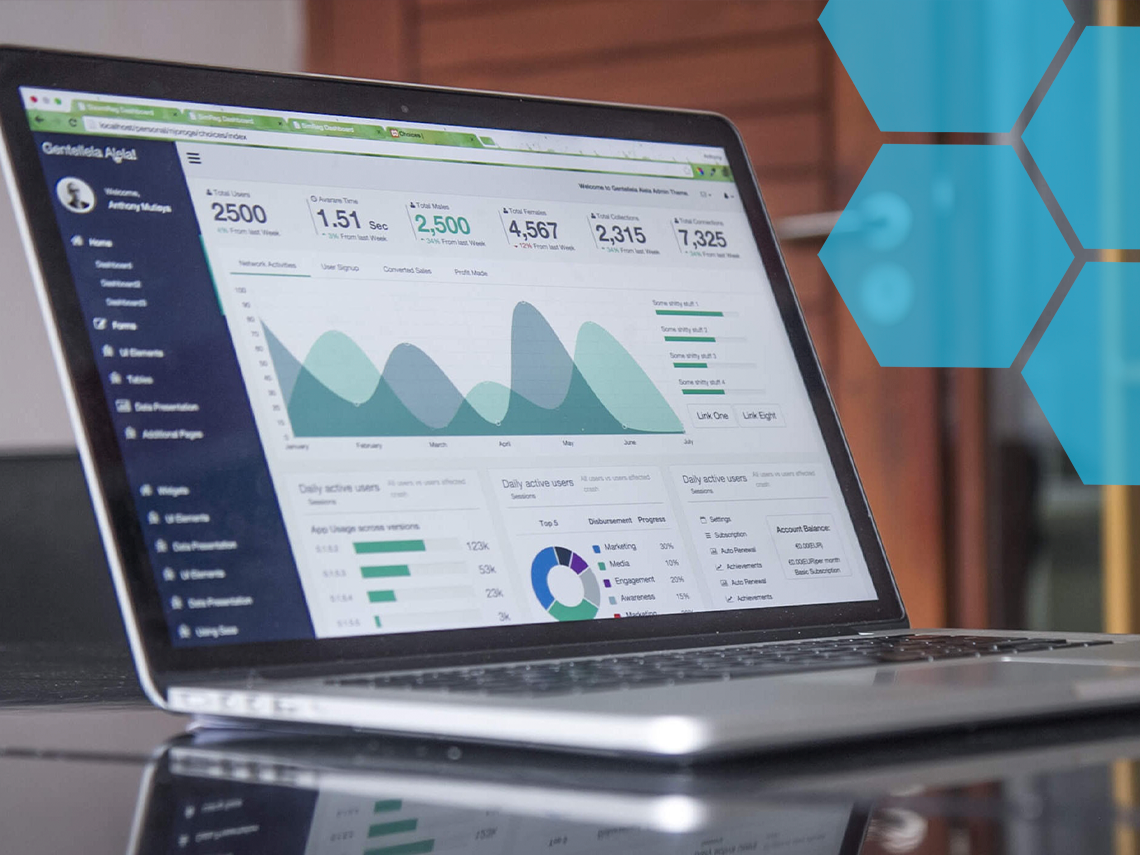2023 offered several sweeping shakeups that shifted what metrics matter on the web and how to track them. Here's your guide of what metrics to track, why they're important and how to create a comprehensive look at your site's performance.
What are Metrics?
When I say "website metrics," what I really mean is "website engagement metrics." We want to look at where and how users engage with your site. The most important metrics are those that give visibility into how users find your site, what page(s) they access, and what they're doing on-page.
How to Track Metrics
For most, the best way to track website engagement metrics is to use Google Analytics. However, analytics can be confusing to parse through, especially if you haven't played with GA4 before. That's why I recommend you start with the metrics below for a clear focus on what to look at in Google Analytics.
There are other tools like SEMRush and HubSpot that will parse the data below for you. These are paid options as opposed to the free Google Analytics, but the benefit is that you'll spend significantly less time figuring out how to get to your data and find usable information.
For this blog, I'll be using the terminology that Google Analytics uses.
What's Changed in 2024?
The metrics that were important to track in the past may not be as important in 2024. When looking at data, it's important to know a few big changes that influenced what metrics are valuable to track.
Updated privacy laws - More websites, users and mobile devices are removing access to first-party data. This means you'll have less visibility into demographic and behavior information for random users.
Google Analytics 4 (GA4) - This year Google launched its biggest analytics update in more than a decade. GA4 is a completely new way of engaging with your website data. This replaced Universal Analytics (UA), which was the previous standard.
AI search updates - With the rise of generative AI and other advanced tools, Google has revisited how it ranks websites and displays information. Google is moving into what they call a search generative experience (SGE) vs. its traditional search algorithm.
→ Related Content: What You Need to Know About Google's AI Search Update
These three factors are all important to consider when browsing the metrics below.

The Metrics That Matter in 2024
1. Traffic Source
Your traffic source tells you where your audience came from. There are 6 primary sources you'll see in GA4, which can be pulled into the default Traffic acquisition report:
- Direct - Users who came directly to your site by typing in the URL or from a bookmark. With privacy updates, it's worth noting that sometimes users may be attributed as direct traffic if cookies are disabled on their browser.
- Organic - Users who came to your site through Google search by clicking on a non-paid link.
- Paid - Users who came to your site through PPC or display media. This includes Google Adwords and social media advertising.
- Organic Social - Users who visited your site from a social media network (but not an ad).
- Referral - Users who clicked a link from somewhere else to visit your site. This encompasses everything not represented in the sources above. Note: organic social traffic can sometimes come through as referral traffic, depending on the user's privacy settings and device.
- Other - This is the catch-all for any traffic that came from somewhere, but it isn't represented above (like emails), or Google can't determine due to a user's privacy settings and device.
Traffic source shows you how people are finding you. Generally speaking, you want organic, paid and direct to be your highest sources of traffic - depending on your marketing strategy and goals.
2. Top Pages
Your Top Pages is a list of the top 10 most accessed pages in a given time period, by page view. This provides tremendous insight into what pages people interact with on your site. Generally, you should expect to see your homepage, any landing pages used for PPC, and some blog posts in your top pages.
2.5. Metric: Page Views (Overall and Per Page)
I'm including this as a bonus metric because while important, it's one that people don't often use correctly. Page views are exactly what they sound like - the overall number of views a page(s) received. You can look at this number overall for your site or per page. A caution with page views: it can be easy to fall into the trap of unrealistic expectations and focus solely on getting the most views. While page views are important, other engagement metrics on this list are a better indicator of your site's performance and ability to generate leads.
3. Entrance and Exit Pages
Entrance and exit pages are the first and last pages a visitor sees on your site. This is different from top pages because a user may access more than one page during their session, which counts toward top pages.
Knowing exactly where people are coming onto your site for the first time can provide invaluable insight. You should expect to see your homepage and any landing pages tied to ads here. If you DON'T - that could be a sign that you need to work on your branding to improve direct traffic (homepage) or that your ads aren't performing well (landing pages).
Similarly, where people exit can give you some insights: If they enter on a landing page, do they also exit on the same landing page, or do they visit other areas of your site?
4. Pages Per Session
Pages per session looks at the average number of pages a user views during one session (or sitting). This is useful to look at globally because it gives you an idea of how many pages users engage with before leaving.
Because of Google's privacy laws, you can't tap into this data for a specific person. However, you can look at geographical trends (like region), age bracket or gender. Just take the data with a grain of salt since it will exclude users who opt out of cookies and other tracking methods. It can be valuable to look at pages per session through the lens of demographics to see if there are any differences.

5. New Users/Returning Users
These popular metrics from UA are available in GA4, but in a slightly different form. The "all users" metric looks at everyone who accessed your site in a given time period, while "new users" are first-time visitors and "returning users" are users who have visited your site before. As with many tracking metrics on this list, just remember that this data might not capture every user. Those who have tracking disabled will not register as returning.
This data can show you how much of your traffic is repeat vs. new. There is no ideal ratio for new vs. returning, as many factors may impact what a "good" number looks like for your website: type of website, industry, business age, etc. For example, an eCommerce website might want to see a ratio of 80/20 returning vs. new, whereas a B2B service-based site might want that ratio flipped.
6. Device Category
Device tracking is another useful metric from UA that carried over into GA4. Device type shows you how people access your site. Not to sound like a broken record, but again: grain of salt, this requires tracking info be enabled.
Depending on the level of tracking enabled by the user, you can see the following data in GA4:
- Device category - The type of device (desktop, mobile or tablet)
- Device brand - For mobile and tablet, the brand name of the device (ex. Motorola, LG, Samsung, Apple)
- Device model - For mobile and tablet, the device's model name (ex. iPhone 15, SM-J500M)
Looking at device type will show you if most of your users are accessing your site on desktop or mobile, which may inform your design and content.
7. Average Session Duration
This was previously known as "time on page" but tracks the same data: the average of how long people stick around on your site. You can look at this metric overall, by section of your site, or by individual pages. I recommend all three for a realistic reference point.
Keep in mind when looking at average session duration the intent and function of the specific page(s) you're exploring. For example, you would expect session duration to be lower on landing pages where users are asked to take one action, whereas on a blog you would expect visitors to hang around longer as they read through the content.
8. Engagement Rate and Bounce Rate
The engagement rate is the percentage of engaged sessions on your website or mobile app. The bounce rate is the opposite of the engagement rate. The bounce rate is the percentage of sessions that were not engaged.
That may seem like a circular definition, so walk with me here.
Engagement rate in GA4 looks at the percentage of meaningfully engaged users, based on the number of engaged sessions. In GA4, an engaged session is a session that lasts longer than 10 seconds, has a conversion event, or has at least 2 pageviews or screenviews.
Bounce rate is where it can get confusing. A bounce in UA meant that a user entered and exited from the same page without viewing other pages. That is no longer what bounce means in GA4. Instead, a bounce is now the inverse of an engaged session: a user left a page before 10 seconds, did not take any action or did not view any other pages. The rate then is the percentage of users who met this criteria.
This is an important distinction to make because it changes how we think of bounce rate. Historically, if a user visited a specific page and left from that same page, that would be a bounce - even if that user had spent more than 10 seconds on the page, scrolled at least 90% or clicked on an external link. Under GA4, that same user behavior would be tagged as an engaged session, NOT as a bounce.
9. Event Tracking
This is a completely new suite of tracking tools within GA4. The most straightforward explanation is that an "event" is "someone doing something" on your page. There are a lot of default events that come with GA4 - find the full list here on Google's help site. The most relevant include:
- When your app is installed or uninstalled on a device
- When a user clicks on a link to another domain from your website
- When a user downloads a file from your website
- The first time a visitor visits your website or uses your app
- When a user reaches 90% scroll depth on a page
- When a user starts, stops, or completes a video
- When a user uses your in-site search function
You can also create custom events to track (more on that in #10).
Events provide a look into people's activities on your site. By default, if you track "events" in Google it will track all of the above in ONE metric. However, you can set up custom reporting to only look at the specific events you want to track within the automatically gathered events.
10. Conversion Events
One of the best features of GA4 is that you can customize your reporting and data to only reflect the information that's most vital to your business. That's where conversion events come in.
The best way to create conversion events is by starting with the main goals of your website. For example, if you're a B2B service-based business, one of your main goals might be for users to submit a request for quote. In that case, you'll want to create a custom event for this action. From there, you'll set that event as a conversion event in GA4. By doing both, you're telling GA4 this isn't just an event, it's a key event to track.
The specific steps of creating an event and marketing it as a conversion can be found in Google's GA4 help section. Or if you're an existing BizzyWeb client, drop us a line and we can do it for you.
Track these metrics to measure your website's performance. The most important takeaway is that with the rise of privacy laws and massive structural changes to Google's algorithm and analytics tools, the most important metrics are the actions people take on your site. Do they line up with what you want them to do? If not, that's a sign it's time to revisit your website's design.
Website Grader: How Strong is Your Website?
Want to improve your website's visibility? Get your website’s grade to find out to improve your results!
Your website is your always-on sales rep, providing prospects with the features and pricing of your services. It also plays a role in customer service, answering questions about your products and services. Your website also serves as an HR team, answering questions about company culture and showing what positions your company currently has available. The list can go on and on…
Get Your Website Grade Today
Grade your website in seconds. Then learn how to improve it for free.





